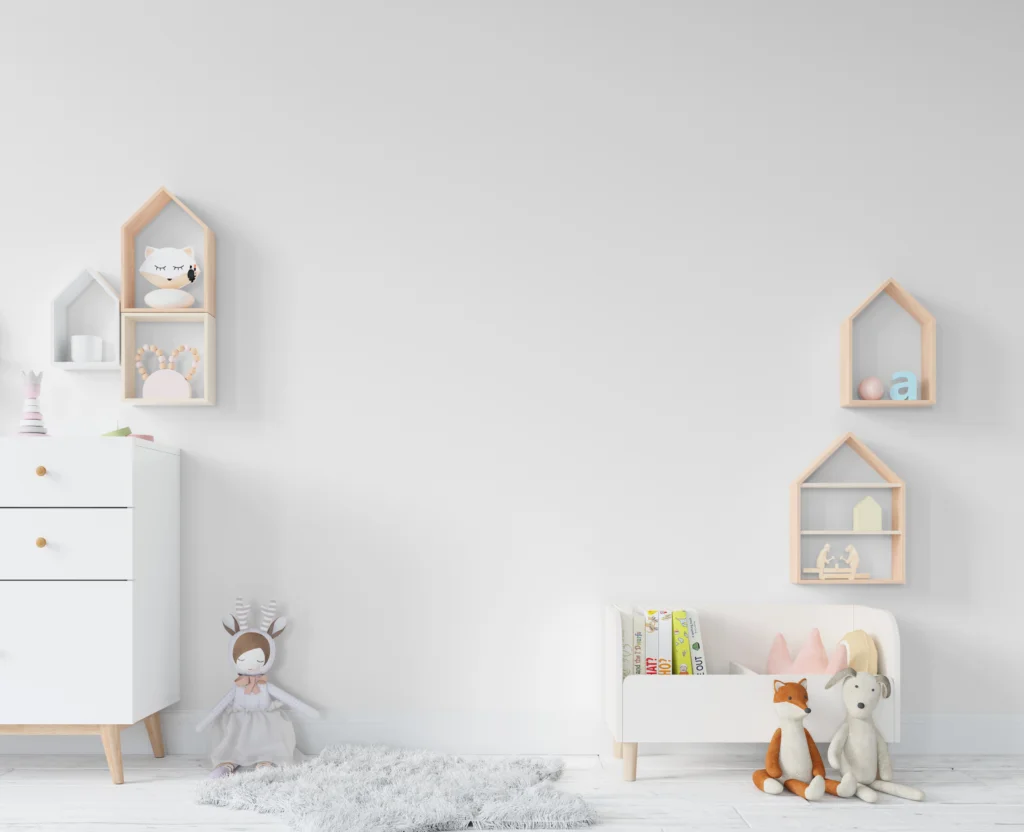Designing a child’s bedroom is a cherished opportunity to weave magic and creativity into a space that not only reflects their individuality but also nurtures their growth and imagination. In this blog, we embark on a journey to create enchanting and personalized havens for the little ones. From embracing the wonders of nature to infusing the room with adaptable lighting and engaging DIY projects, each aspect is carefully curated to foster a space where dreams take flight.
Let the journey begin, as we unlock the secrets to designing kids’ bedrooms that not only captivate the eye but also ignite the spark of wonder and creativity in the hearts of our little ones and every corner holds the promise of enchantment!
I. Color Psychology for Kids’ Rooms: Creating a Vibrant Haven
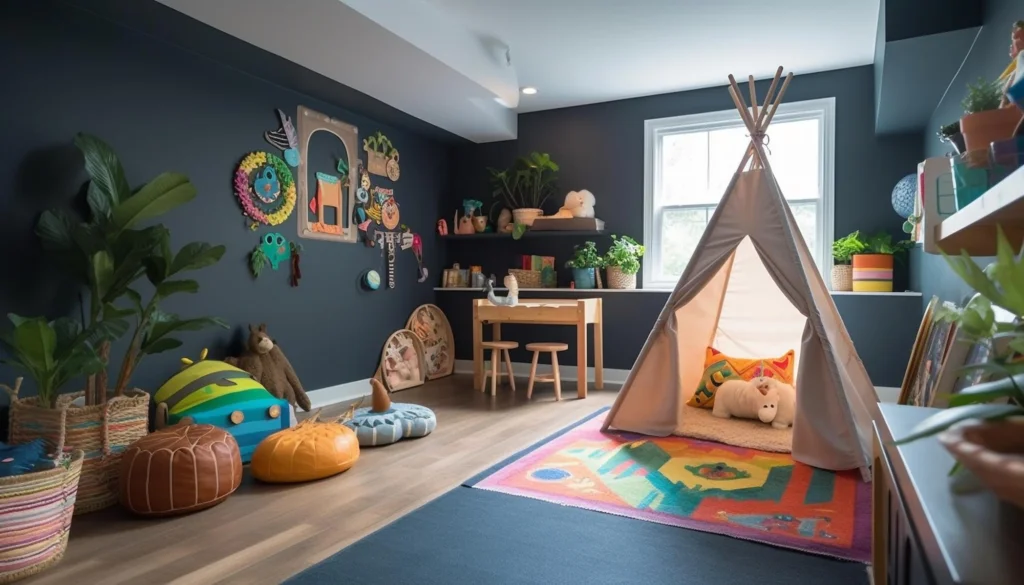
Color plays a pivotal role in shaping the emotional and psychological well-being of children. When it comes to designing a kids’ room, understanding color psychology is crucial for fostering a space that promotes positivity, creativity, and a sense of security.
Listing a few colors and their Impact on Children’s Mood and Behavior:
Blue:
Calming Influence: Blue is known for its calming effects, making it an excellent choice for a child’s bedroom. It promotes tranquility and relaxation, aiding in a peaceful sleep environment.
Consider using soft shades of blue for the walls or bedding to create a serene atmosphere conducive to restful nights.
Yellow:
Energetic and Cheerful: Yellow is associated with energy and optimism, making it an ideal color to inspire creativity and a positive mindset in children.
Integrate pops of yellow through accent pieces like throw pillows, rugs, or wall art to inject a sense of joy into the room.
Green:
Balanced and Refreshing: Green symbolizes nature and balance, providing a refreshing and harmonious atmosphere. It’s particularly beneficial for promoting concentration and relaxation.
Example: Incorporate green through wall paint or decor items like potted plants to connect the room with the outdoors, fostering a sense of tranquility.
Pink:
Warmth and Comfort: Pink is often associated with feelings of warmth and comfort. It’s a popular choice for creating a nurturing environment, especially in girls’ bedrooms.
Use shades of pink for bedding, curtains, or wall accents to infuse a sense of coziness and tenderness.
Purple:
Creativity and Luxury: Purple is linked to creativity and luxury. It can stimulate a child’s imagination while maintaining a sense of sophistication.
Integrate purple through decor elements like throw blankets, cushions, or a feature wall for a touch of whimsy.
Orange:
Energetic and Playful: Orange is a warm and vibrant color that radiates positivity and energy, making it an excellent choice for play areas.
Use orange in moderation through accessories like storage bins, artwork, or playful furniture to add zest to the room.
Neutral Tones:
Versatility and Serenity: Neutrals like beige, gray, or soft tones of white offer versatility and a serene backdrop. They create a canvas for adding pops of vibrant colors through accessories.
Choose neutral shades for larger surfaces like walls and furniture, allowing for flexibility in updating the room’s look over time.
By carefully considering the psychological impact of colors, parents can confidently choose a palette that not only reflects their child’s personality but also nurtures a positive and inspiring atmosphere in the kids’ room. We would extend this conversation where if we feel a child is overenergetic, his room should be filled with calm colors. So ever so subtly the colors can play on the subconscious of the child.
II. Space-Saving Furniture Solutions for Kids’ Bedrooms: Maximizing Functionality and Playfulness
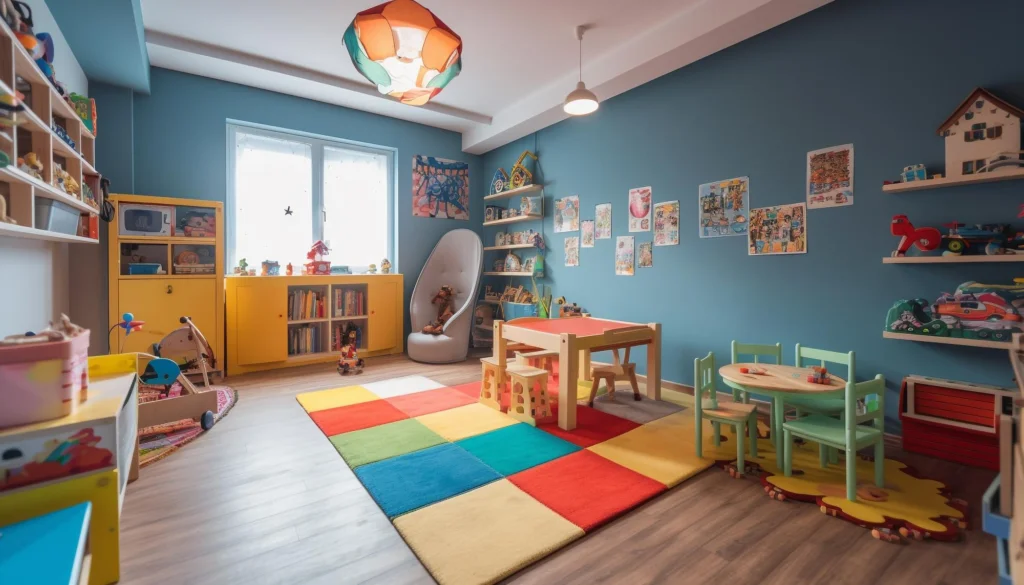
When it comes to designing kids’ bedrooms, space is often a precious commodity. Maximizing the available space efficiently is not only practical but also essential for creating an environment that fosters creativity, playfulness, and organization. Here’s a detailed exploration of space-saving furniture solutions, including the ingenious use of wall beds and folding study tables.
Significance of Maximizing Space:
Promoting Play and Movement:
Limited space can hinder a child’s ability to play freely and engage in physical activities. Maximizing space allows for the incorporation of play zones where kids can explore their creativity without feeling cramped.
Designate a specific area for play with easily accessible toys and games, ensuring that the room remains conducive to both rest and play.
Creating a Clutter-Free Environment:
An organized space contributes to a calm and focused mindset. Maximizing storage solutions helps keep toys, books, and other items neatly tucked away, reducing visual clutter.
Invest in storage bins, shelving units, and under-bed storage to create designated spaces for different items, promoting a clutter-free and organized room.
Adapting to Changing Needs:
Children’s needs evolve as they grow, and a flexible space accommodates these changes seamlessly. Maximizing space allows for easy transformation from a playroom for toddlers to a study space for older kids.
Choose furniture that can be adjusted or repurposed over time, such as modular shelving units that can be reconfigured to suit changing storage needs.
Multifunctional Furniture for Play and Storage:
Wall Beds (Murphy Beds):
Wall beds are a game-changer for maximizing floor space. During the day, the bed can be folded up against the wall, creating a spacious play area. At night, it easily unfolds for a comfortable night’s sleep.
Install a wall bed with an attached desk or storage unit, providing a versatile solution that combines sleeping and study spaces in a single furniture piece.
Folding Study Tables:
Foldable study tables are excellent for creating a dedicated study space without compromising play area. When not in use, the table can be folded down, freeing up valuable floor space.
Choose a folding study table that can be mounted on the wall or integrated into a shelving unit.
Bunk Beds with Storage:
Bunk beds are classic space-savers, and modern designs often come with built-in storage options. This is a practical solution for siblings sharing a room or for maximizing sleepover space.
Opt for bunk beds with drawers underneath or attached shelving units to provide additional storage for clothes, toys, or books.
Convertible Furniture:
Invest in convertible furniture that serves multiple functions. For example, a sofa that can transform into a bed or a coffee table that can extend into a play table.
Consider a convertible sofa that doubles as a guest bed or a play table that can be adjusted to different heights, catering to various activities.
Floating Shelves and Wall Cubbies:
Utilize vertical space with floating shelves and wall cubbies. These not only serve as stylish decor but also offer practical storage solutions for books, toys, and decorative items.
Install floating shelves above a study desk or along the perimeter of the room to display toys and keep frequently used items within easy reach.
In conclusion, the careful selection of space-saving furniture not only optimizes the available area in kids’ bedrooms but also enhances the functionality of the space, promoting an environment that is both practical and enjoyable for children at every stage of their development.
III. Customized Bedding and Linens: Reflecting Ever-Changing Interests

Personalized bedding is a powerful tool in transforming a kids’ bedroom into a unique and inviting space that evolves with the child’s ever-changing interests. The beauty lies in its adaptability, allowing for an easy shift of themes as the child discovers new passions.
The role of personalized bedding goes beyond mere aesthetics; it contributes to the child’s sense of identity and comfort within their space. Opting for customizable bedding sets enables parents to tailor the room to the child’s preferences, whether it’s a fascination with animals, superheroes, or fairy tales.
The ease of updating themes ensures that the bedroom remains a dynamic reflection of the child’s current interests. For instance, a bedding set featuring dinosaurs can effortlessly transition to outer space explorations or marine life, allowing the room to grow alongside the child. This adaptability not only nurtures creativity but also fosters a sense of ownership over their personal space.
Themes and characters that resonate with the child’s interests can include favorite cartoon characters, sports, hobbies, or even elements from their favorite books. Personalized linens featuring these themes create a cohesive and visually appealing environment, making the bedroom a haven for both play and rest.
IV. Educational Play Zones: Integrating Learning into Design
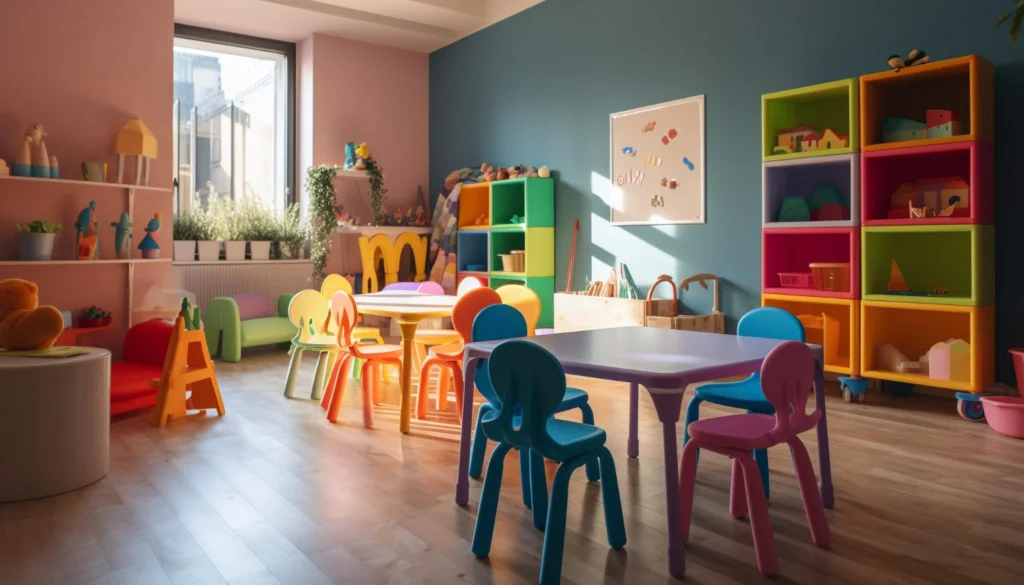
Creating an educational play zone within the kids’ bedroom is a brilliant way to foster a love for learning in a familiar and comfortable environment. By seamlessly integrating educational elements into the design, parents can inspire curiosity and intellectual development through play.
Integration of Educational Elements:
Educational play zones can incorporate elements that stimulate cognitive development. Consider educational wall decals featuring numbers, letters, or even a world map to introduce basic concepts in a playful manner. Utilize furniture with built-in learning features, such as storage bins labeled with numbers or a table with an integrated puzzle surface.
Creative Ways to Incorporate Learning:
The key is to make learning an inherent part of play. Introduce educational games, puzzles, or interactive toys that promote problem-solving and critical thinking. For example, a magnetic alphabet wall can serve as both a decorative element and a tool for learning letter recognition.
Chalkboard Laminates for Creative Expression:
One innovative way to encourage a child’s creativity and expression is to integrate chalkboard laminates or paints into the room’s design. By incorporating these surfaces into shutter designs or on specific walls, parents provide a designated area for the child to unleash their artistic instincts. This not only fulfills the child’s desire to draw on walls but also focuses their creative energy within defined boundaries.
Chalkboard surfaces add an interactive and dynamic element to the room. These writable surfaces act as a canvas for the child to express themselves freely, fostering imagination and artistic development. Whether it’s doodling, practicing letters, or creating masterpieces, chalkboard laminates provide a space for creative expression while maintaining the integrity of the overall design.
This intentional design choice not only engages the child in a constructive and entertaining activity but also protects the rest of the home from impromptu artistic endeavors. The defined chalkboard area becomes a centerpiece of the room, capturing the child’s attention and leaving the rest of the home in a pristine condition.
The integration of customized bedding, linens, and chalkboard laminates into the design of an educational play zone transforms a kids’ bedroom into a dynamic space that not only reflects the child’s current interests but also nurtures their intellectual growth and creative expression through play. The result is a personalized and educational haven that adapts seamlessly to the evolving needs of the child while maintaining the aesthetics of the home.
V. Safety Measures and Child-Friendly Materials: Prioritizing Well-being in Kids’ Bedrooms
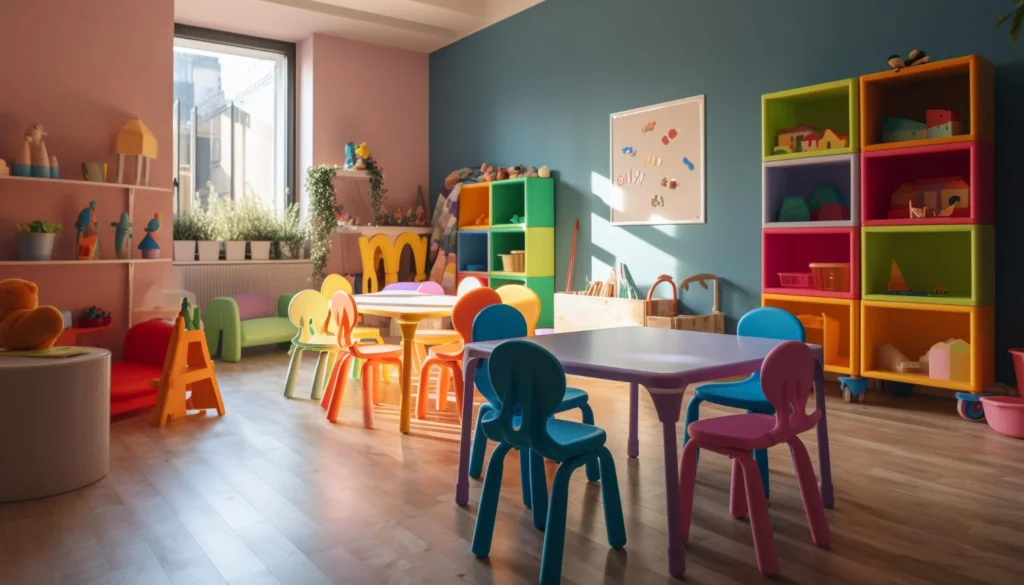
Ensuring the safety of children is paramount when designing their bedrooms. The materials and furnishings chosen play a crucial role in creating a secure environment that nurtures their well-being. Emphasizing child safety in design choices goes beyond aesthetics, focusing on the use of non-toxic and durable materials to minimize potential risks.
Importance of Child Safety in Design:
Childproof design is more than just a trend; it’s a fundamental aspect of creating a space where children can explore and play without unnecessary hazards. Prioritizing safety in design choices contributes to a secure and nurturing environment for growing minds.
Preference for Wood Over Laminates:
In the realm of materials, opting for wood over laminates is a prudent choice for several reasons. Wood, with its soft edges, is inherently more child-friendly. The natural texture and warmth of wood create a comforting atmosphere. Choosing wood treated with a basic oil polish adds an extra layer of safety, ensuring that the material is non-toxic and gentle on a child’s sensitive skin.
Go All Wood for Edges and Tabletops:
When it comes to furniture, consider designs with all-wood for edges and tabletops. This design choice not only enhances the aesthetic appeal of the room but also eliminates sharp corners and edges that could pose a risk. Smooth, rounded edges minimize the chance of accidental bumps and bruises, creating a safer environment for active play.
Water-Based and Non-Toxic Paints:
For painted surfaces, prioritize water-based and non-toxic paints. These paints eliminate harmful fumes and are safe for children who might be prone to exploring their surroundings through touch and taste. The use of such paints also contributes to a cleanliness-friendly environment, as they are easier to clean and maintain.
Minimal Grooves and Edges:
Incorporating furniture with minimal grooves and edges further reduces the risk of accidents. Smooth surfaces are not only aesthetically pleasing but also easier to keep clean. This design choice aligns with the principles of child safety and ensures that the room remains a secure haven for exploration and play.
Prioritizing child safety in design choices involves a thoughtful selection of materials and furnishings. The preference for wood over laminates, the use of all-wood edges, water-based and non-toxic paints, and a focus on minimal grooves and edges collectively contribute to a safe, secure, and aesthetically pleasing environment in kids’ bedrooms. By incorporating these principles, parents can create a space that promotes not only the physical safety but also the overall well-being of their children.
VI. Smart Lighting for Different Moods: Illuminating Creativity and Comfort in Kids’ Bedrooms

In the realm of kids’ bedroom design, lighting is a powerful tool that goes beyond mere functionality. Introducing the concept of adaptable lighting not only serves practical purposes but also contributes to creating an atmosphere that suits various activities and moods, fostering a dynamic and engaging environment.
Adaptable Lighting for Varied Activities:
The idea behind adaptable lighting is to cater to the diverse needs of a child’s day. From energetic playtime to quiet bedtime stories, the lighting in a kids’ room should be versatile. Adjustable fixtures, such as dimmable ceiling lights or task lamps, provide the flexibility to customize the illumination based on the specific activity at hand. Bright, vibrant lighting can enhance focus during play or study sessions, while softer, dimmed lighting sets a cozy ambiance for winding down before bedtime.
Highlighting Smart Lighting Options:
Smart lighting technology takes adaptability to the next level. Incorporating smart lighting options in a kids’ bedroom adds a layer of convenience and creativity. Smart bulbs, for instance, can be controlled through a mobile app, allowing parents to adjust the color temperature and brightness remotely. This is particularly useful for parents who want to create a specific mood without entering the room, whether it’s calming blues for bedtime or vibrant hues for playtime.
Colorful and Creative Lighting Scenes:
Smart lighting systems often offer the option to create pre-set scenes, enabling parents and children to choose from a variety of colors and intensities. This feature not only serves functional purposes but also becomes a source of creative expression for the child. Encourage kids to experiment with different lighting scenes, allowing them to personalize their space and set the mood according to their preferences.
Integration with Smart Home Ecosystems:
For added convenience, consider smart lighting options that integrate with popular smart home ecosystems. This allows for voice-activated controls through virtual assistants, adding an element of interactivity for children. For example, a simple command can transform the lighting to a bedtime setting or activate a vibrant lighting scene for play.
The concept of adaptable lighting in kids’ bedrooms opens up a realm of possibilities for creating a versatile, engaging, and personalized environment. By incorporating smart lighting options, parents not only enhance convenience but also provide children with a creative outlet to express themselves and set the mood for different activities in their personal space.
VII. Incorporating Nature Indoors in a Kids’ Room: Cultivating Growth and Connection
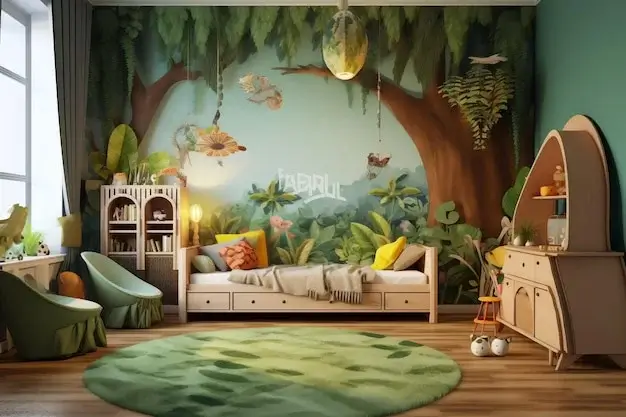
Bringing elements of nature into kids’ bedrooms is not just a design choice; it’s a holistic approach that fosters a sense of well-being, responsibility, and connection with the environment. By exploring the benefits of nature-inspired design and suggesting creative ideas, parents can cultivate a space that nurtures both the physical and emotional growth of their children.
Benefits of Nature in Kids’ Bedrooms:
The introduction of natural elements indoors has numerous benefits for children. It provides a calming and grounding effect, reducing stress and promoting a sense of tranquility. Exposure to nature has also been linked to improved cognitive development, creativity, and overall well-being. Incorporating nature into a child’s daily environment can instill a lifelong appreciation for the natural world.
Planters for Hands-On Learning:
One tangible way to bring nature indoors is through the use of planters. Setting up small indoor gardens with child-friendly plants not only enhances the aesthetic appeal of the room but also serves as a hands-on learning opportunity. Children can take charge of watering, observing growth, and learning about the life cycle of plants, instilling a sense of responsibility and care.
Nature-Themed Decor:
Consider incorporating nature-themed decor to create a visually appealing and cohesive design. Wall decals featuring trees, animals, or outdoor scenes can transform the room into a woodland wonderland. Bedding, rugs, and curtains adorned with nature-inspired patterns further enhance the theme, bringing the beauty of the outdoors into the child’s personal space.
Wallpaper to Create Immersive Environments:
For a more immersive experience, explore nature-themed wallpaper options. Whether it’s a forest mural, a starry night sky, or an underwater scene, wallpaper can transport children to different realms of nature within the comfort of their own rooms. This not only stimulates their imagination but also creates a serene and inspiring atmosphere for play and rest.
In conclusion, incorporating nature into kids’ bedrooms is a transformative design choice that goes beyond aesthetics. By embracing planters, nature-themed decor, and immersive wallpaper, parents not only enhance the visual appeal of the room but also provide children with valuable opportunities for hands-on learning, responsibility, and a deep connection with the natural world. The result is a harmonious and nurturing environment that supports the holistic development of the child.
VIII. DIY Crafts and Personalized Decor Projects: Crafting Memories in Kids’ Bedrooms
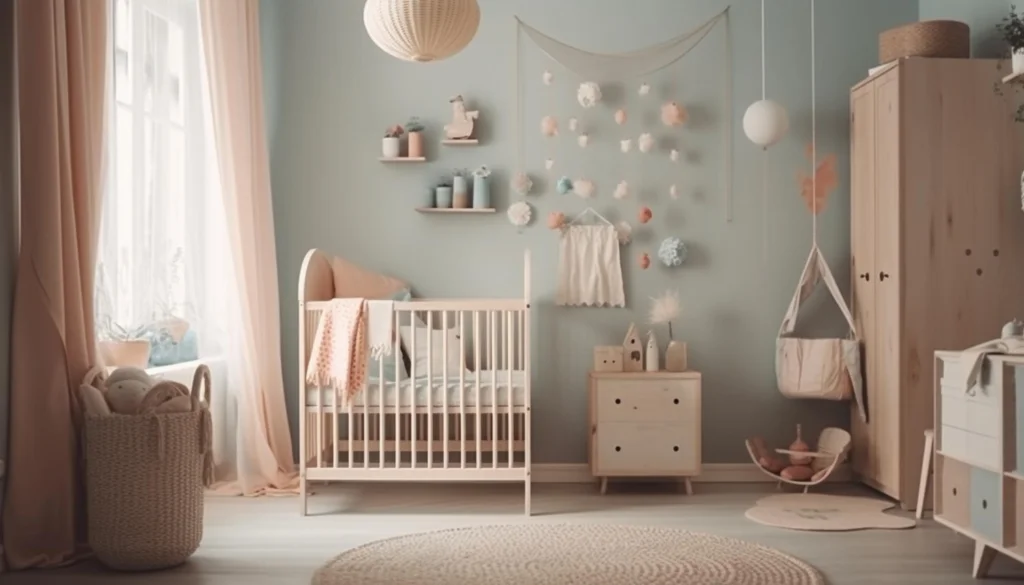
Encouraging parents to involve their children in the design process of their bedrooms is not just about creating a visually appealing space; it’s an opportunity to foster creativity, strengthen bonds, and build lasting memories. By providing easy and fun DIY decor ideas, parents can empower their children to infuse their personality into their personal space, creating a room that truly reflects their unique interests and style.
Involving Children in the Design Process:
The design process becomes a memorable and enjoyable experience when children actively participate. Begin by having a conversation with them about their favorite colors, hobbies, and interests. Consider creating a mood board together, filled with images, colors, and themes that resonate with the child. This collaborative approach ensures that the room is a true reflection of the child’s personality and preferences.
Examples of DIY Decor Ideas:
Personalized Wall Art:
Create a collaborative piece of wall art by letting the child paint or draw on a canvas. Frame their artwork and display it as a centerpiece in the room. This not only adds a personal touch but also boosts the child’s confidence and pride in their creations.
DIY Name Banner:
Craft a personalized name banner using colorful felt, string, and fabric paint. This simple yet impactful DIY project allows children to see their name proudly displayed in their room, adding a sense of ownership and identity.
Photo Collage Wall:
Encourage the child to curate a photo collage wall featuring their favorite memories, drawings, and photographs. This interactive and ever-evolving display becomes a visual journey of their growth and experiences.
Themed DIY Pillows:
Transform plain throw pillows into personalized masterpieces by letting the child paint or decorate them with fabric markers. This DIY project allows for creativity and ensures that the pillows complement the overall theme of the room.
Homemade Dream Catchers:
Craft dream catchers together using embroidery hoops, yarn, and decorative elements. Personalize each dream catcher with charms or items that hold special meaning to the child, creating a whimsical and meaningful addition to the room.
In conclusion, involving children in the design process of their bedrooms through DIY crafts and personalized decor projects is a delightful and enriching experience. The resulting decor not only adds a unique and personal touch to the room but also creates lasting memories of collaboration and creativity. Parents can empower their children to take pride in their space and, in the process, nurture a sense of creativity and self-expression.
In the tapestry of designing enchanting kids’ bedrooms, we’ve embarked on a journey that goes beyond mere decor. It’s about creating spaces where laughter echoes, dreams take root, and memories blossom. By infusing nature’s wonders, incorporating adaptable lighting, and embracing the magic of personalized DIY projects, we’ve laid the foundation for rooms that are not just visually appealing but are living, breathing extensions of a child’s vibrant spirit.
As parents, caregivers, and designers, we hold the brush to paint the canvas of our children’s memories. From the gentle glow of smart lighting to the soft edges of child-safe materials, every decision is a stroke that shapes a haven of love and growth. These bedrooms aren’t just spaces; they are living stories, evolving with each chapter of a child’s life.
So, let these rooms be a sanctuary where curiosity is sparked, creativity is celebrated, and the joy of discovery is ever-present. As we conclude this exploration into the art of crafting magical spaces, may these insights inspire you to design not just rooms but realms of wonder and warmth, where childhood dreams find a forever home. Happy crafting!


